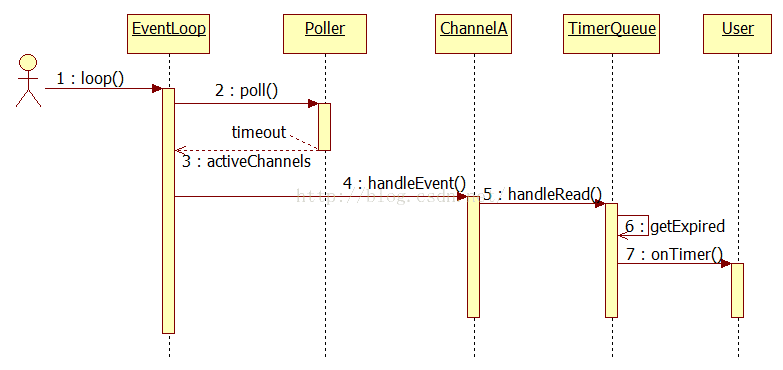Muduo网络库源码分析(二) 定时器TimeQueue,Timer,TimerId
首先,我们先要明白为什么需要设计这样一个定时器类?
在开发Linux网络程序时,通常需要维护多个定时器,如维护客户端心跳时间、检查多个数据包的超时重传等。如果采用Linux的SIGALARM信号实现,则会带来较大的系统开销,且不便于管理。
Muduo 的 TimerQueue 采用了最简单的实现(链表)来管理定时器,它的效率比不上常见的 binary heap 的做法,如果程序中大量(10 个以上)使用重复触发的定时器,或许值得考虑改用更高级的实现。由于目前还没有在一个程序里用过这么多定时器,暂时也不需要优化 TimerQueue。
(一)定时函数的选取
定时函数,用于让程序等待一段时间或安排计划任务:
sleep
alarm
usleep
nanosleep
clock_nanosleep
getitimer / setitimer
timer_create / timer_settime / timer_gettime / timer_delete
timerfd_create / timerfd_gettime / timerfd_settime
最终我们选择了下面的函数:
#include
int timerfd_create(int clockid, int flags);
// timerfd_create() creates a new timer object, and returns a file descriptor that refers to that timer.
int timerfd_settime(int fd, int flags, const struct itimerspec *new_value, struct itimerspec *old_value);
int timerfd_gettime(int fd, struct itimerspec *curr_value) timerfd_* 入选的原因:
(1)sleep / alarm / usleep 在实现时有可能用了信号 SIGALRM,在多线程程序中处理信号是个相当麻烦的事情,应当尽量避免。(2)nanosleep 和 clock_nanosleep 是线程安全的,但是在非阻塞网络编程中,绝对不能用让线程挂起的方式来等待一段时间,程序会失去响应。正确的做法是注册一个时间回调函数。
(3)getitimer 和 timer_create 也是用信号来 deliver 超时,在多线程程序中也会有麻烦。
(4)timer_create 可以指定信号的接收方是进程还是线程,算是一个进步,不过在信号处理函数(signal handler)能做的事情实在很受限。
(5)timerfd_create 把时间变成了一个文件描述符,该“文件”在定时器超时的那一刻变得可读,这样就能很方便地融入到 select/poll 框架中,用统一的方式来处理 IO 事件和超时事件,这也正是 Reactor 模式的长处。
传统的Reactor 利用select/poll/epoll 的timeout 来实现定时功能,但poll 和epoll 的定时精度只有毫秒,远低于timerfd_settime 的定时精度。
(二)TimerId、Timer、TimerQueue分析
muduo的定时器由三个类实现,TimerId、Timer、TimerQueue,用户只能看到第一个类,其它两个都是内部实现细节
TimerQueue的接口很简单,只有两个函数addTimer和cancel。
EventLoop
runAt 在某个时刻运行定时器
runAfter 过一段时间运行定时器
runEvery 每隔一段时间运行定时器
cancel 取消定时器
TimerQueue数据结构的选择,能快速根据当前时间找到已到期的定时器,也要高效的添加和删除Timer,因而可以用二叉搜索树,用map或者set
typedef std::pair
typedef std::set
#ifndef MUDUO_NET_TIMERID_H
#define MUDUO_NET_TIMERID_H
#include
namespace muduo
{
namespace net
{
class Timer;
/// An opaque identifier, for canceling Timer.
class TimerId : public muduo::copyable
{
public:
TimerId()
: timer_(NULL),
sequence_(0)
{
}
TimerId(Timer* timer, int64_t seq)
: timer_(timer),
sequence_(seq)
{
}
// default copy-ctor, dtor and assignment are okay
friend class TimerQueue;
private:
Timer* timer_;
int64_t sequence_;
};
}
}
#endif // MUDUO_NET_TIMERID_H
/// Internal class for timer event.
///
class Timer : boost::noncopyable
{
public:
Timer(const TimerCallback& cb, Timestamp when, double interval)
: callback_(cb),
expiration_(when),
interval_(interval),
repeat_(interval > 0.0),
sequence_(s_numCreated_.incrementAndGet())
{ }
void run() const
{
callback_();
}
Timestamp expiration() const { return expiration_; }
bool repeat() const { return repeat_; }
int64_t sequence() const { return sequence_; }
void restart(Timestamp now);
static int64_t numCreated() { return s_numCreated_.get(); }
private:
const TimerCallback callback_; // 定时器回调函数
Timestamp expiration_; // 下一次的超时时刻
const double interval_; // 超时时间间隔,如果是一次性定时器,该值为0
const bool repeat_; // 是否重复
const int64_t sequence_; // 定时器序号
static AtomicInt64 s_numCreated_; // 定时器计数,当前已经创建的定时器数量
};
}
}
class TimerQueue : boost::noncopyable
{
public:
TimerQueue(EventLoop* loop);
~TimerQueue();
///
/// Schedules the callback to be run at given time,
/// repeats if @c interval > 0.0.
///
/// Must be thread safe. Usually be called from other threads.
// 一定是线程安全的,可以跨线程调用。通常情况下被其它线程调用。
TimerId addTimer(const TimerCallback& cb,
Timestamp when,
double interval);
void cancel(TimerId timerId);
private:
// FIXME: use unique_ptr instead of raw pointers.
// unique_ptr是C++ 11标准的一个独享所有权的智能指针
// 无法得到指向同一对象的两个unique_ptr指针
// 但可以进行移动构造与移动赋值操作,即所有权可以移动到另一个对象(而非拷贝构造)
typedef std::pair Entry;
typedef std::set TimerList;
typedef std::pair ActiveTimer;
typedef std::set ActiveTimerSet;
// 以下成员函数只可能在其所属的I/O线程中调用,因而不必加锁。
// 服务器性能杀手之一是锁竞争,所以要尽可能少用锁
void addTimerInLoop(Timer* timer);
void cancelInLoop(TimerId timerId);
// called when timerfd alarms
void handleRead();
// move out all expired timers
// 返回超时的定时器列表
std::vector getExpired(Timestamp now);
void reset(const std::vector& expired, Timestamp now);
bool insert(Timer* timer);
EventLoop* loop_; // 所属EventLoop
const int timerfd_;
Channel timerfdChannel_;
// Timer list sorted by expiration
TimerList timers_; // timers_是按到期时间排序
// for cancel()
// timers_与activeTimers_保存的是相同的数据
// timers_是按到期时间排序,activeTimers_是按对象地址排序
ActiveTimerSet activeTimers_;
bool callingExpiredTimers_; /* atomic */
ActiveTimerSet cancelingTimers_; // 保存的是被取消的定时器
};
struct Foo
{
Foo() { cout << "Foo ctor" << endl; }
Foo(const Foo&) { cout << "Foo copy ctor" << endl; }
void operator=(const Foo&) { cout << "Foo operator=" << endl; }
~Foo() { cout << "Foo dtor" << endl; }
};
Foo make_foo()
{
Foo f;
return f;
} 